Project: Nestle's Recruitment, Selection and Training of Employees
VerifiedAdded on 2023/01/20
|26
|4355
|51
Project
AI Summary
This project report analyzes Nestle's approach to recruitment, selection, and training to meet international requirements. It begins with an introduction to globalization and its impact on businesses, followed by an examination of Nestle's operations. The project outlines aims, objectives, and research questions, and includes a literature review on globalization, recruitment, selection, and training. A project management plan, incorporating cost, time, scope, communication, quality, risk, and resources, is presented. The report also features a Gantt chart and work breakdown structure, along with a discussion of qualitative and quantitative data collection methods, including a questionnaire. Data analysis and interpretation are conducted, leading to recommendations for improving Nestle's employee performance. The report concludes with a reflection on the importance of the research and personal experiences.

MANAGING A
SUCCESSFUL BUSINESS
PROJECT
SUCCESSFUL BUSINESS
PROJECT
Paraphrase This Document
Need a fresh take? Get an instant paraphrase of this document with our AI Paraphraser
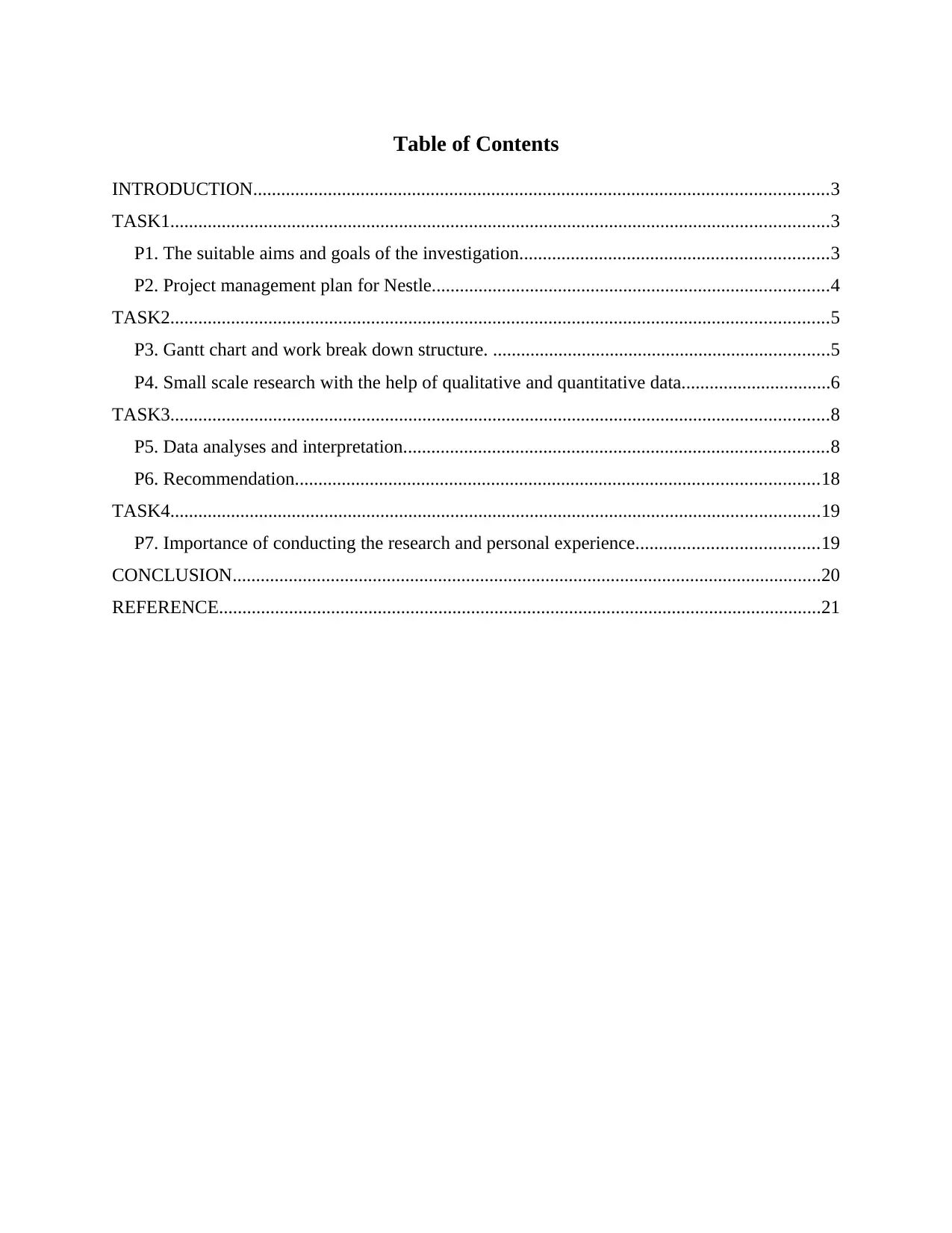
Table of Contents
INTRODUCTION...........................................................................................................................3
TASK1.............................................................................................................................................3
P1. The suitable aims and goals of the investigation..................................................................3
P2. Project management plan for Nestle.....................................................................................4
TASK2.............................................................................................................................................5
P3. Gantt chart and work break down structure. ........................................................................5
P4. Small scale research with the help of qualitative and quantitative data................................6
TASK3.............................................................................................................................................8
P5. Data analyses and interpretation...........................................................................................8
P6. Recommendation................................................................................................................18
TASK4...........................................................................................................................................19
P7. Importance of conducting the research and personal experience.......................................19
CONCLUSION..............................................................................................................................20
REFERENCE.................................................................................................................................21
INTRODUCTION...........................................................................................................................3
TASK1.............................................................................................................................................3
P1. The suitable aims and goals of the investigation..................................................................3
P2. Project management plan for Nestle.....................................................................................4
TASK2.............................................................................................................................................5
P3. Gantt chart and work break down structure. ........................................................................5
P4. Small scale research with the help of qualitative and quantitative data................................6
TASK3.............................................................................................................................................8
P5. Data analyses and interpretation...........................................................................................8
P6. Recommendation................................................................................................................18
TASK4...........................................................................................................................................19
P7. Importance of conducting the research and personal experience.......................................19
CONCLUSION..............................................................................................................................20
REFERENCE.................................................................................................................................21
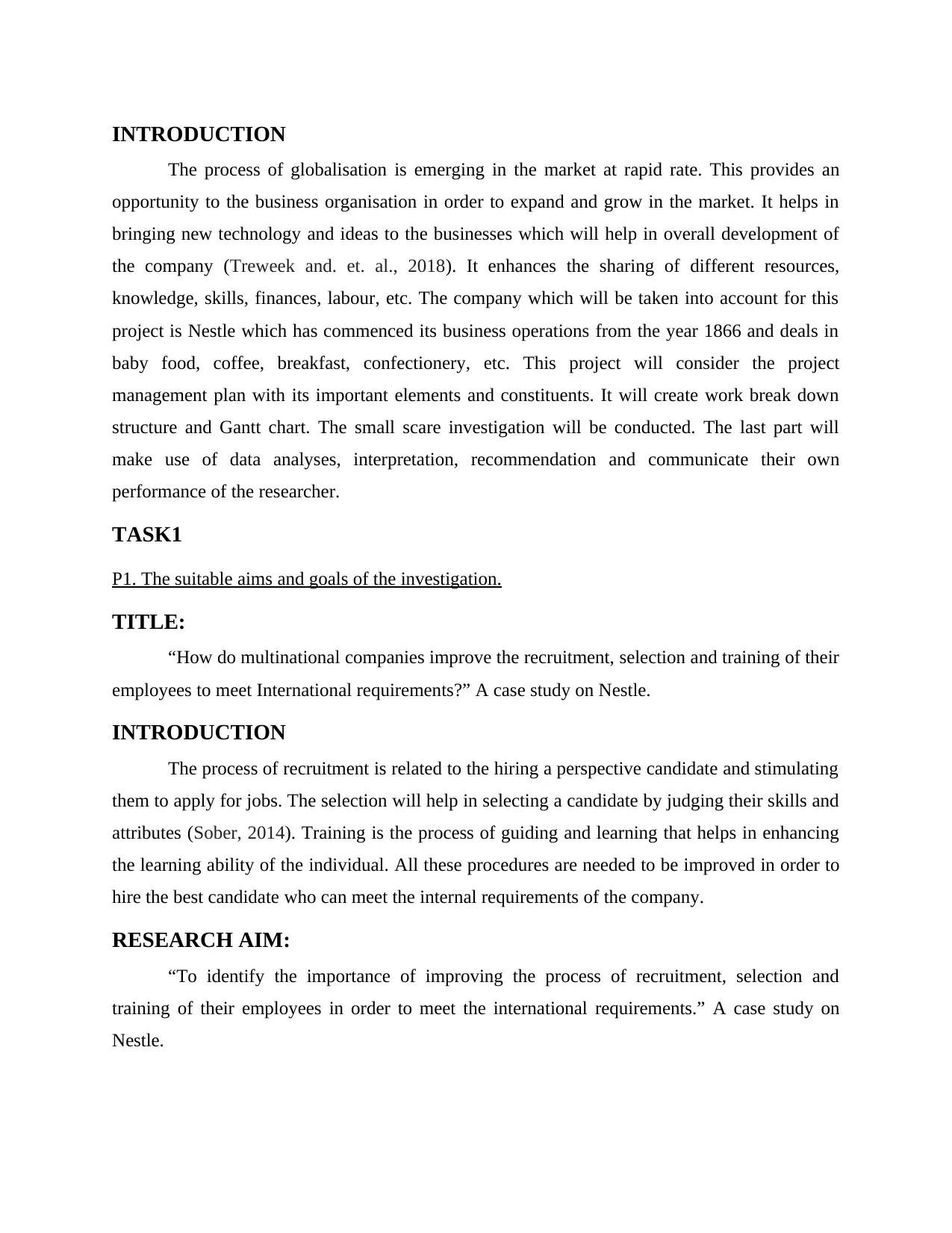
INTRODUCTION
The process of globalisation is emerging in the market at rapid rate. This provides an
opportunity to the business organisation in order to expand and grow in the market. It helps in
bringing new technology and ideas to the businesses which will help in overall development of
the company (Treweek and. et. al., 2018). It enhances the sharing of different resources,
knowledge, skills, finances, labour, etc. The company which will be taken into account for this
project is Nestle which has commenced its business operations from the year 1866 and deals in
baby food, coffee, breakfast, confectionery, etc. This project will consider the project
management plan with its important elements and constituents. It will create work break down
structure and Gantt chart. The small scare investigation will be conducted. The last part will
make use of data analyses, interpretation, recommendation and communicate their own
performance of the researcher.
TASK1
P1. The suitable aims and goals of the investigation.
TITLE:
“How do multinational companies improve the recruitment, selection and training of their
employees to meet International requirements?” A case study on Nestle.
INTRODUCTION
The process of recruitment is related to the hiring a perspective candidate and stimulating
them to apply for jobs. The selection will help in selecting a candidate by judging their skills and
attributes (Sober, 2014). Training is the process of guiding and learning that helps in enhancing
the learning ability of the individual. All these procedures are needed to be improved in order to
hire the best candidate who can meet the internal requirements of the company.
RESEARCH AIM:
“To identify the importance of improving the process of recruitment, selection and
training of their employees in order to meet the international requirements.” A case study on
Nestle.
The process of globalisation is emerging in the market at rapid rate. This provides an
opportunity to the business organisation in order to expand and grow in the market. It helps in
bringing new technology and ideas to the businesses which will help in overall development of
the company (Treweek and. et. al., 2018). It enhances the sharing of different resources,
knowledge, skills, finances, labour, etc. The company which will be taken into account for this
project is Nestle which has commenced its business operations from the year 1866 and deals in
baby food, coffee, breakfast, confectionery, etc. This project will consider the project
management plan with its important elements and constituents. It will create work break down
structure and Gantt chart. The small scare investigation will be conducted. The last part will
make use of data analyses, interpretation, recommendation and communicate their own
performance of the researcher.
TASK1
P1. The suitable aims and goals of the investigation.
TITLE:
“How do multinational companies improve the recruitment, selection and training of their
employees to meet International requirements?” A case study on Nestle.
INTRODUCTION
The process of recruitment is related to the hiring a perspective candidate and stimulating
them to apply for jobs. The selection will help in selecting a candidate by judging their skills and
attributes (Sober, 2014). Training is the process of guiding and learning that helps in enhancing
the learning ability of the individual. All these procedures are needed to be improved in order to
hire the best candidate who can meet the internal requirements of the company.
RESEARCH AIM:
“To identify the importance of improving the process of recruitment, selection and
training of their employees in order to meet the international requirements.” A case study on
Nestle.
⊘ This is a preview!⊘
Do you want full access?
Subscribe today to unlock all pages.

Trusted by 1+ million students worldwide
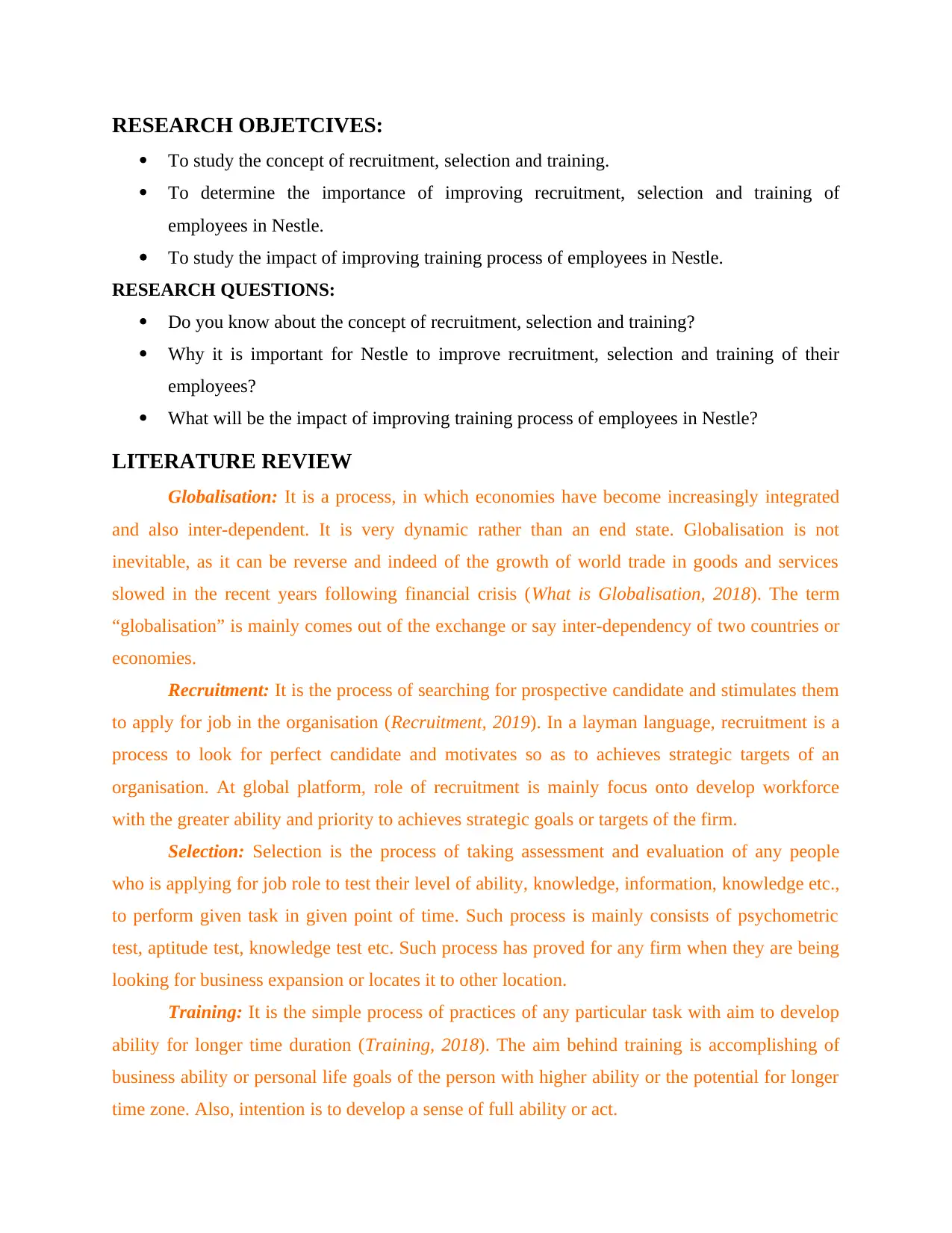
RESEARCH OBJETCIVES:
To study the concept of recruitment, selection and training.
To determine the importance of improving recruitment, selection and training of
employees in Nestle.
To study the impact of improving training process of employees in Nestle.
RESEARCH QUESTIONS:
Do you know about the concept of recruitment, selection and training?
Why it is important for Nestle to improve recruitment, selection and training of their
employees?
What will be the impact of improving training process of employees in Nestle?
LITERATURE REVIEW
Globalisation: It is a process, in which economies have become increasingly integrated
and also inter-dependent. It is very dynamic rather than an end state. Globalisation is not
inevitable, as it can be reverse and indeed of the growth of world trade in goods and services
slowed in the recent years following financial crisis (What is Globalisation, 2018). The term
“globalisation” is mainly comes out of the exchange or say inter-dependency of two countries or
economies.
Recruitment: It is the process of searching for prospective candidate and stimulates them
to apply for job in the organisation (Recruitment, 2019). In a layman language, recruitment is a
process to look for perfect candidate and motivates so as to achieves strategic targets of an
organisation. At global platform, role of recruitment is mainly focus onto develop workforce
with the greater ability and priority to achieves strategic goals or targets of the firm.
Selection: Selection is the process of taking assessment and evaluation of any people
who is applying for job role to test their level of ability, knowledge, information, knowledge etc.,
to perform given task in given point of time. Such process is mainly consists of psychometric
test, aptitude test, knowledge test etc. Such process has proved for any firm when they are being
looking for business expansion or locates it to other location.
Training: It is the simple process of practices of any particular task with aim to develop
ability for longer time duration (Training, 2018). The aim behind training is accomplishing of
business ability or personal life goals of the person with higher ability or the potential for longer
time zone. Also, intention is to develop a sense of full ability or act.
To study the concept of recruitment, selection and training.
To determine the importance of improving recruitment, selection and training of
employees in Nestle.
To study the impact of improving training process of employees in Nestle.
RESEARCH QUESTIONS:
Do you know about the concept of recruitment, selection and training?
Why it is important for Nestle to improve recruitment, selection and training of their
employees?
What will be the impact of improving training process of employees in Nestle?
LITERATURE REVIEW
Globalisation: It is a process, in which economies have become increasingly integrated
and also inter-dependent. It is very dynamic rather than an end state. Globalisation is not
inevitable, as it can be reverse and indeed of the growth of world trade in goods and services
slowed in the recent years following financial crisis (What is Globalisation, 2018). The term
“globalisation” is mainly comes out of the exchange or say inter-dependency of two countries or
economies.
Recruitment: It is the process of searching for prospective candidate and stimulates them
to apply for job in the organisation (Recruitment, 2019). In a layman language, recruitment is a
process to look for perfect candidate and motivates so as to achieves strategic targets of an
organisation. At global platform, role of recruitment is mainly focus onto develop workforce
with the greater ability and priority to achieves strategic goals or targets of the firm.
Selection: Selection is the process of taking assessment and evaluation of any people
who is applying for job role to test their level of ability, knowledge, information, knowledge etc.,
to perform given task in given point of time. Such process is mainly consists of psychometric
test, aptitude test, knowledge test etc. Such process has proved for any firm when they are being
looking for business expansion or locates it to other location.
Training: It is the simple process of practices of any particular task with aim to develop
ability for longer time duration (Training, 2018). The aim behind training is accomplishing of
business ability or personal life goals of the person with higher ability or the potential for longer
time zone. Also, intention is to develop a sense of full ability or act.
Paraphrase This Document
Need a fresh take? Get an instant paraphrase of this document with our AI Paraphraser
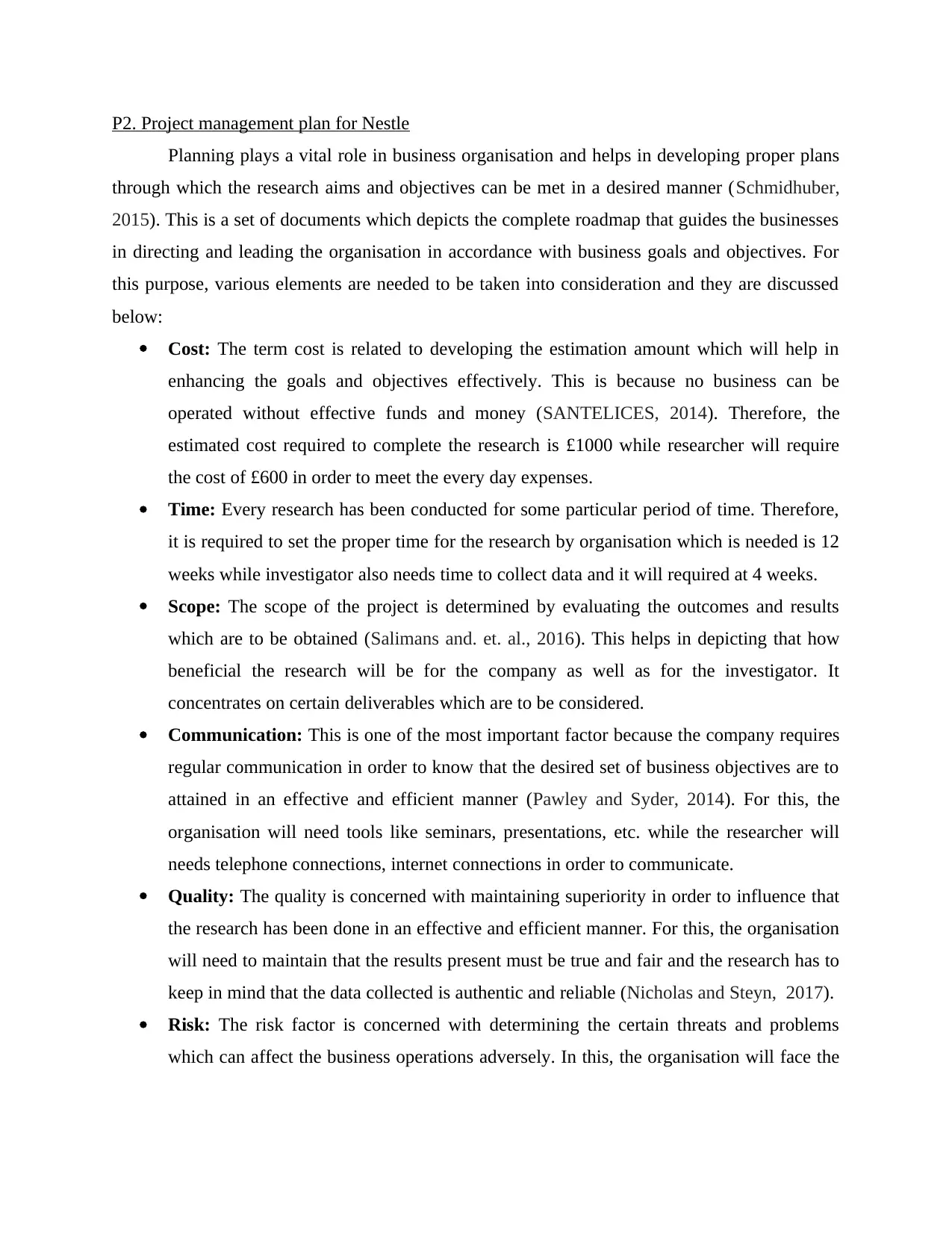
P2. Project management plan for Nestle
Planning plays a vital role in business organisation and helps in developing proper plans
through which the research aims and objectives can be met in a desired manner (Schmidhuber,
2015). This is a set of documents which depicts the complete roadmap that guides the businesses
in directing and leading the organisation in accordance with business goals and objectives. For
this purpose, various elements are needed to be taken into consideration and they are discussed
below:
Cost: The term cost is related to developing the estimation amount which will help in
enhancing the goals and objectives effectively. This is because no business can be
operated without effective funds and money (SANTELICES, 2014). Therefore, the
estimated cost required to complete the research is £1000 while researcher will require
the cost of £600 in order to meet the every day expenses.
Time: Every research has been conducted for some particular period of time. Therefore,
it is required to set the proper time for the research by organisation which is needed is 12
weeks while investigator also needs time to collect data and it will required at 4 weeks.
Scope: The scope of the project is determined by evaluating the outcomes and results
which are to be obtained (Salimans and. et. al., 2016). This helps in depicting that how
beneficial the research will be for the company as well as for the investigator. It
concentrates on certain deliverables which are to be considered.
Communication: This is one of the most important factor because the company requires
regular communication in order to know that the desired set of business objectives are to
attained in an effective and efficient manner (Pawley and Syder, 2014). For this, the
organisation will need tools like seminars, presentations, etc. while the researcher will
needs telephone connections, internet connections in order to communicate.
Quality: The quality is concerned with maintaining superiority in order to influence that
the research has been done in an effective and efficient manner. For this, the organisation
will need to maintain that the results present must be true and fair and the research has to
keep in mind that the data collected is authentic and reliable (Nicholas and Steyn, 2017).
Risk: The risk factor is concerned with determining the certain threats and problems
which can affect the business operations adversely. In this, the organisation will face the
Planning plays a vital role in business organisation and helps in developing proper plans
through which the research aims and objectives can be met in a desired manner (Schmidhuber,
2015). This is a set of documents which depicts the complete roadmap that guides the businesses
in directing and leading the organisation in accordance with business goals and objectives. For
this purpose, various elements are needed to be taken into consideration and they are discussed
below:
Cost: The term cost is related to developing the estimation amount which will help in
enhancing the goals and objectives effectively. This is because no business can be
operated without effective funds and money (SANTELICES, 2014). Therefore, the
estimated cost required to complete the research is £1000 while researcher will require
the cost of £600 in order to meet the every day expenses.
Time: Every research has been conducted for some particular period of time. Therefore,
it is required to set the proper time for the research by organisation which is needed is 12
weeks while investigator also needs time to collect data and it will required at 4 weeks.
Scope: The scope of the project is determined by evaluating the outcomes and results
which are to be obtained (Salimans and. et. al., 2016). This helps in depicting that how
beneficial the research will be for the company as well as for the investigator. It
concentrates on certain deliverables which are to be considered.
Communication: This is one of the most important factor because the company requires
regular communication in order to know that the desired set of business objectives are to
attained in an effective and efficient manner (Pawley and Syder, 2014). For this, the
organisation will need tools like seminars, presentations, etc. while the researcher will
needs telephone connections, internet connections in order to communicate.
Quality: The quality is concerned with maintaining superiority in order to influence that
the research has been done in an effective and efficient manner. For this, the organisation
will need to maintain that the results present must be true and fair and the research has to
keep in mind that the data collected is authentic and reliable (Nicholas and Steyn, 2017).
Risk: The risk factor is concerned with determining the certain threats and problems
which can affect the business operations adversely. In this, the organisation will face the
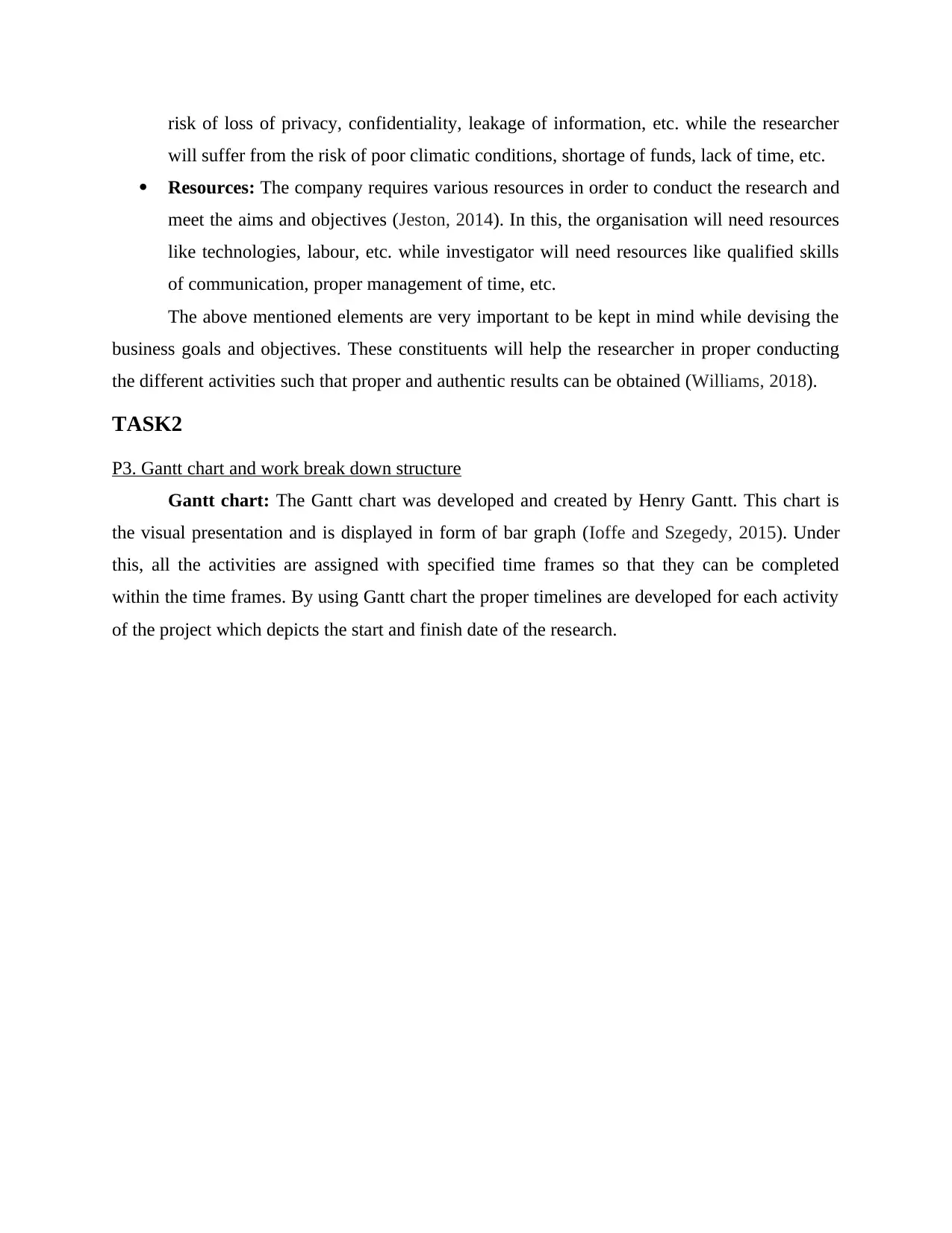
risk of loss of privacy, confidentiality, leakage of information, etc. while the researcher
will suffer from the risk of poor climatic conditions, shortage of funds, lack of time, etc.
Resources: The company requires various resources in order to conduct the research and
meet the aims and objectives (Jeston, 2014). In this, the organisation will need resources
like technologies, labour, etc. while investigator will need resources like qualified skills
of communication, proper management of time, etc.
The above mentioned elements are very important to be kept in mind while devising the
business goals and objectives. These constituents will help the researcher in proper conducting
the different activities such that proper and authentic results can be obtained (Williams, 2018).
TASK2
P3. Gantt chart and work break down structure
Gantt chart: The Gantt chart was developed and created by Henry Gantt. This chart is
the visual presentation and is displayed in form of bar graph (Ioffe and Szegedy, 2015). Under
this, all the activities are assigned with specified time frames so that they can be completed
within the time frames. By using Gantt chart the proper timelines are developed for each activity
of the project which depicts the start and finish date of the research.
will suffer from the risk of poor climatic conditions, shortage of funds, lack of time, etc.
Resources: The company requires various resources in order to conduct the research and
meet the aims and objectives (Jeston, 2014). In this, the organisation will need resources
like technologies, labour, etc. while investigator will need resources like qualified skills
of communication, proper management of time, etc.
The above mentioned elements are very important to be kept in mind while devising the
business goals and objectives. These constituents will help the researcher in proper conducting
the different activities such that proper and authentic results can be obtained (Williams, 2018).
TASK2
P3. Gantt chart and work break down structure
Gantt chart: The Gantt chart was developed and created by Henry Gantt. This chart is
the visual presentation and is displayed in form of bar graph (Ioffe and Szegedy, 2015). Under
this, all the activities are assigned with specified time frames so that they can be completed
within the time frames. By using Gantt chart the proper timelines are developed for each activity
of the project which depicts the start and finish date of the research.
⊘ This is a preview!⊘
Do you want full access?
Subscribe today to unlock all pages.

Trusted by 1+ million students worldwide
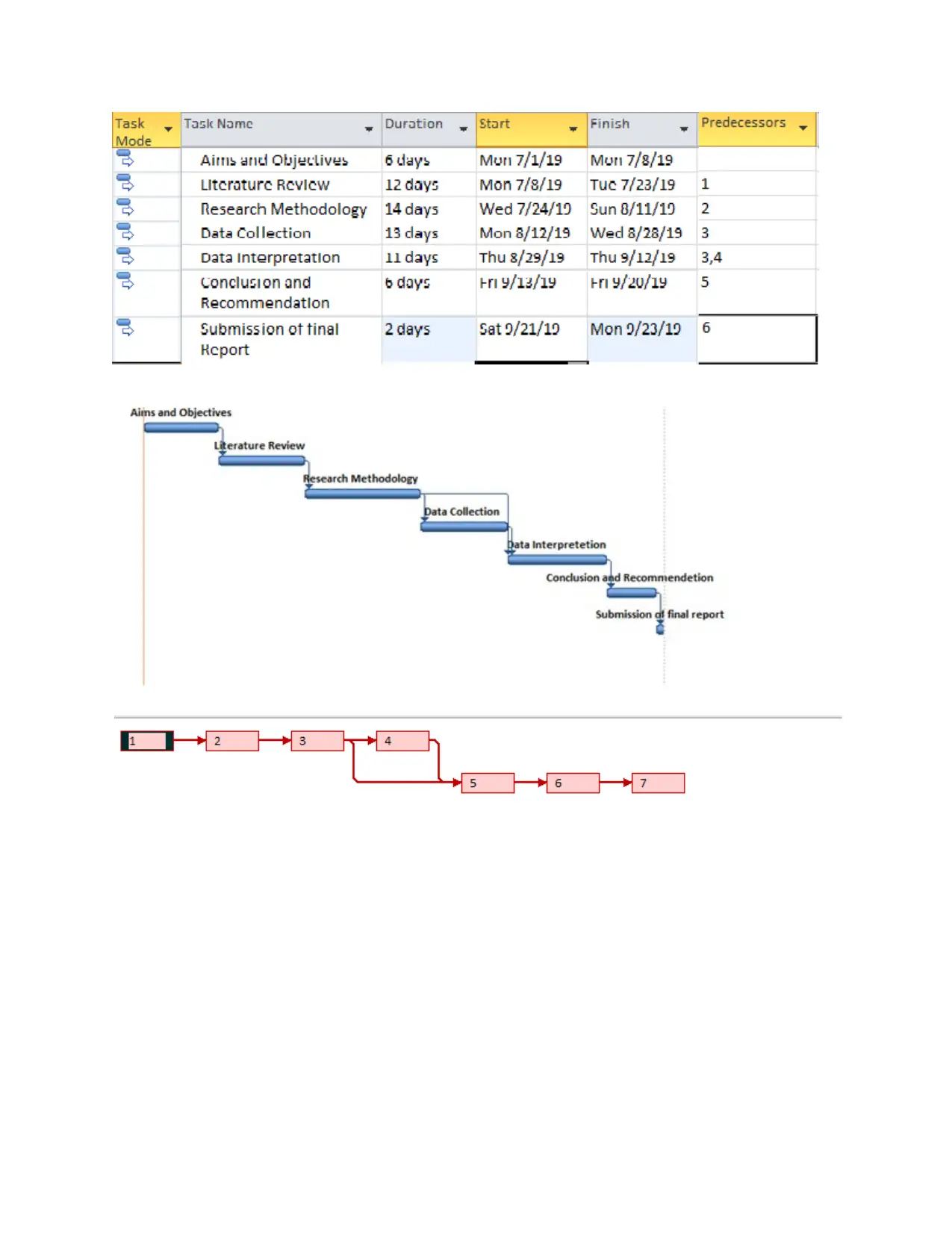
Paraphrase This Document
Need a fresh take? Get an instant paraphrase of this document with our AI Paraphraser
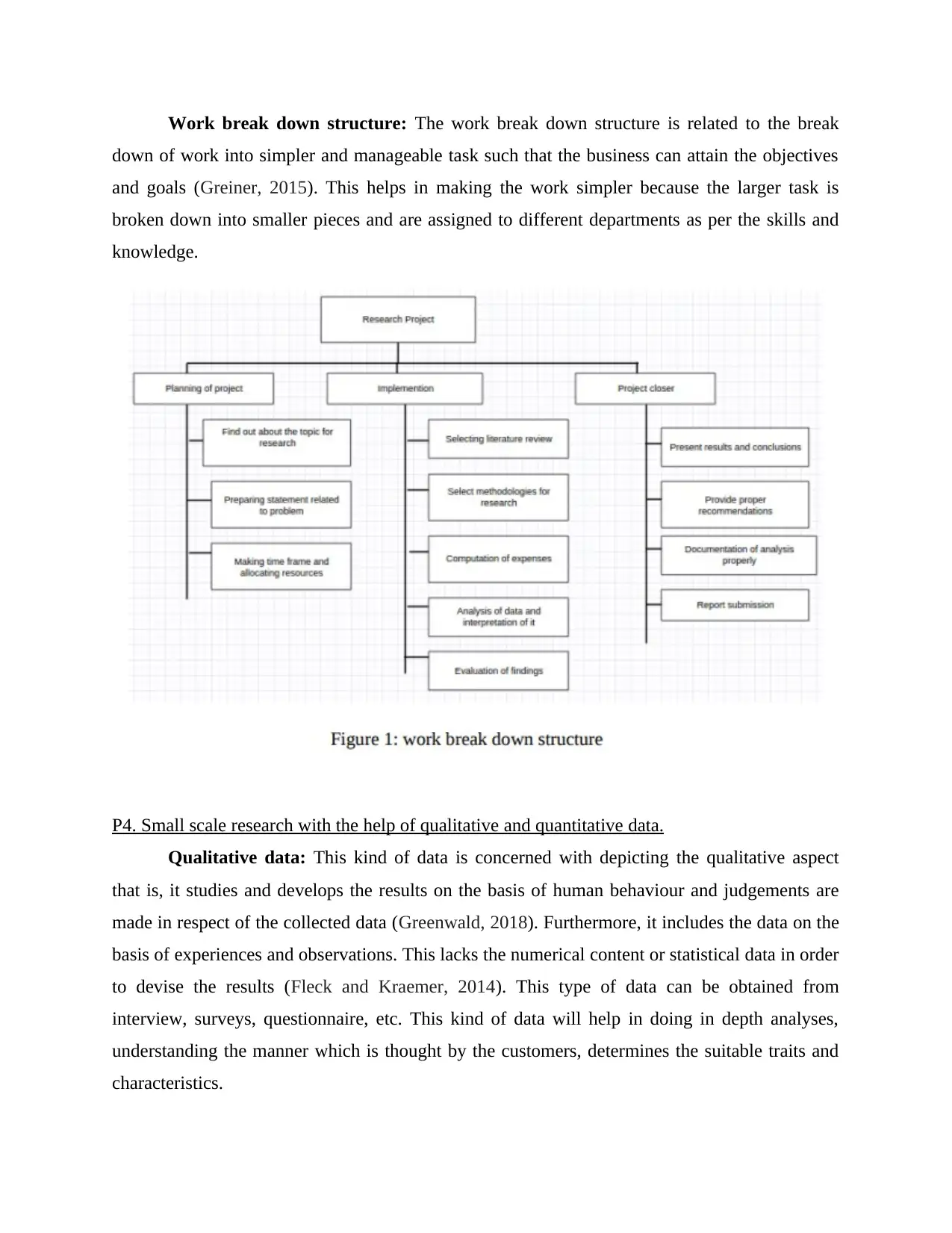
Work break down structure: The work break down structure is related to the break
down of work into simpler and manageable task such that the business can attain the objectives
and goals (Greiner, 2015). This helps in making the work simpler because the larger task is
broken down into smaller pieces and are assigned to different departments as per the skills and
knowledge.
P4. Small scale research with the help of qualitative and quantitative data.
Qualitative data: This kind of data is concerned with depicting the qualitative aspect
that is, it studies and develops the results on the basis of human behaviour and judgements are
made in respect of the collected data (Greenwald, 2018). Furthermore, it includes the data on the
basis of experiences and observations. This lacks the numerical content or statistical data in order
to devise the results (Fleck and Kraemer, 2014). This type of data can be obtained from
interview, surveys, questionnaire, etc. This kind of data will help in doing in depth analyses,
understanding the manner which is thought by the customers, determines the suitable traits and
characteristics.
down of work into simpler and manageable task such that the business can attain the objectives
and goals (Greiner, 2015). This helps in making the work simpler because the larger task is
broken down into smaller pieces and are assigned to different departments as per the skills and
knowledge.
P4. Small scale research with the help of qualitative and quantitative data.
Qualitative data: This kind of data is concerned with depicting the qualitative aspect
that is, it studies and develops the results on the basis of human behaviour and judgements are
made in respect of the collected data (Greenwald, 2018). Furthermore, it includes the data on the
basis of experiences and observations. This lacks the numerical content or statistical data in order
to devise the results (Fleck and Kraemer, 2014). This type of data can be obtained from
interview, surveys, questionnaire, etc. This kind of data will help in doing in depth analyses,
understanding the manner which is thought by the customers, determines the suitable traits and
characteristics.
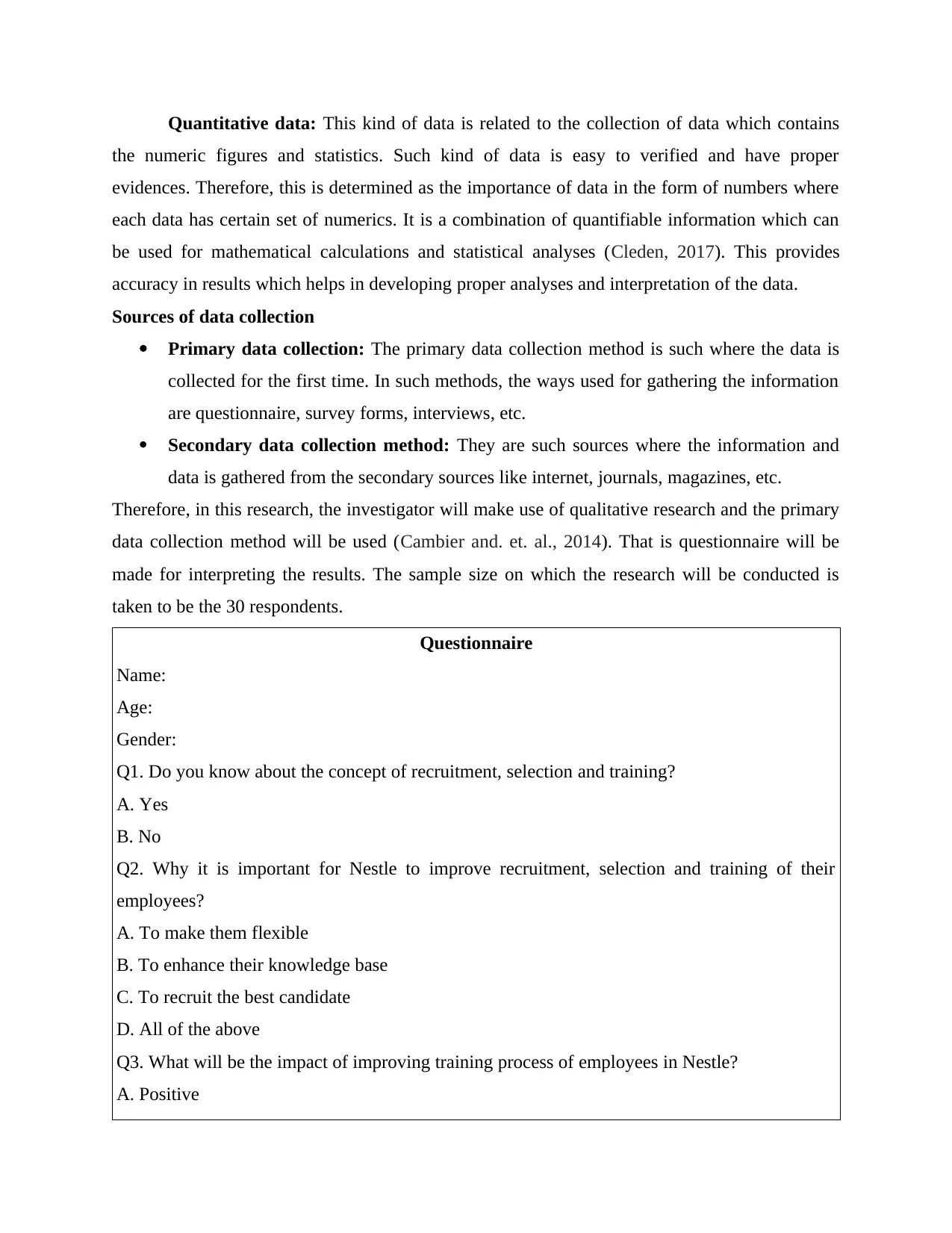
Quantitative data: This kind of data is related to the collection of data which contains
the numeric figures and statistics. Such kind of data is easy to verified and have proper
evidences. Therefore, this is determined as the importance of data in the form of numbers where
each data has certain set of numerics. It is a combination of quantifiable information which can
be used for mathematical calculations and statistical analyses (Cleden, 2017). This provides
accuracy in results which helps in developing proper analyses and interpretation of the data.
Sources of data collection
Primary data collection: The primary data collection method is such where the data is
collected for the first time. In such methods, the ways used for gathering the information
are questionnaire, survey forms, interviews, etc.
Secondary data collection method: They are such sources where the information and
data is gathered from the secondary sources like internet, journals, magazines, etc.
Therefore, in this research, the investigator will make use of qualitative research and the primary
data collection method will be used (Cambier and. et. al., 2014). That is questionnaire will be
made for interpreting the results. The sample size on which the research will be conducted is
taken to be the 30 respondents.
Questionnaire
Name:
Age:
Gender:
Q1. Do you know about the concept of recruitment, selection and training?
A. Yes
B. No
Q2. Why it is important for Nestle to improve recruitment, selection and training of their
employees?
A. To make them flexible
B. To enhance their knowledge base
C. To recruit the best candidate
D. All of the above
Q3. What will be the impact of improving training process of employees in Nestle?
A. Positive
the numeric figures and statistics. Such kind of data is easy to verified and have proper
evidences. Therefore, this is determined as the importance of data in the form of numbers where
each data has certain set of numerics. It is a combination of quantifiable information which can
be used for mathematical calculations and statistical analyses (Cleden, 2017). This provides
accuracy in results which helps in developing proper analyses and interpretation of the data.
Sources of data collection
Primary data collection: The primary data collection method is such where the data is
collected for the first time. In such methods, the ways used for gathering the information
are questionnaire, survey forms, interviews, etc.
Secondary data collection method: They are such sources where the information and
data is gathered from the secondary sources like internet, journals, magazines, etc.
Therefore, in this research, the investigator will make use of qualitative research and the primary
data collection method will be used (Cambier and. et. al., 2014). That is questionnaire will be
made for interpreting the results. The sample size on which the research will be conducted is
taken to be the 30 respondents.
Questionnaire
Name:
Age:
Gender:
Q1. Do you know about the concept of recruitment, selection and training?
A. Yes
B. No
Q2. Why it is important for Nestle to improve recruitment, selection and training of their
employees?
A. To make them flexible
B. To enhance their knowledge base
C. To recruit the best candidate
D. All of the above
Q3. What will be the impact of improving training process of employees in Nestle?
A. Positive
⊘ This is a preview!⊘
Do you want full access?
Subscribe today to unlock all pages.

Trusted by 1+ million students worldwide
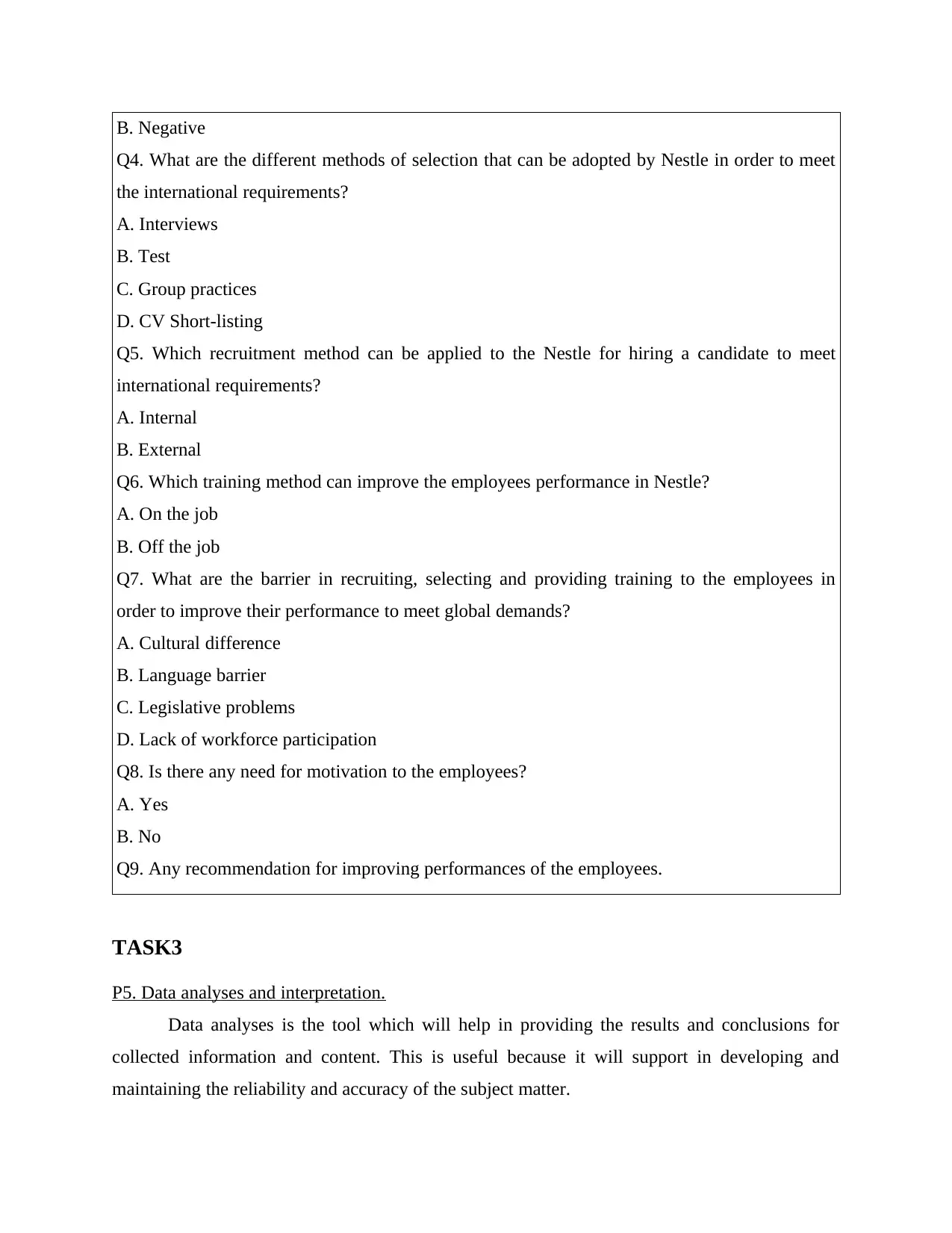
B. Negative
Q4. What are the different methods of selection that can be adopted by Nestle in order to meet
the international requirements?
A. Interviews
B. Test
C. Group practices
D. CV Short-listing
Q5. Which recruitment method can be applied to the Nestle for hiring a candidate to meet
international requirements?
A. Internal
B. External
Q6. Which training method can improve the employees performance in Nestle?
A. On the job
B. Off the job
Q7. What are the barrier in recruiting, selecting and providing training to the employees in
order to improve their performance to meet global demands?
A. Cultural difference
B. Language barrier
C. Legislative problems
D. Lack of workforce participation
Q8. Is there any need for motivation to the employees?
A. Yes
B. No
Q9. Any recommendation for improving performances of the employees.
TASK3
P5. Data analyses and interpretation.
Data analyses is the tool which will help in providing the results and conclusions for
collected information and content. This is useful because it will support in developing and
maintaining the reliability and accuracy of the subject matter.
Q4. What are the different methods of selection that can be adopted by Nestle in order to meet
the international requirements?
A. Interviews
B. Test
C. Group practices
D. CV Short-listing
Q5. Which recruitment method can be applied to the Nestle for hiring a candidate to meet
international requirements?
A. Internal
B. External
Q6. Which training method can improve the employees performance in Nestle?
A. On the job
B. Off the job
Q7. What are the barrier in recruiting, selecting and providing training to the employees in
order to improve their performance to meet global demands?
A. Cultural difference
B. Language barrier
C. Legislative problems
D. Lack of workforce participation
Q8. Is there any need for motivation to the employees?
A. Yes
B. No
Q9. Any recommendation for improving performances of the employees.
TASK3
P5. Data analyses and interpretation.
Data analyses is the tool which will help in providing the results and conclusions for
collected information and content. This is useful because it will support in developing and
maintaining the reliability and accuracy of the subject matter.
Paraphrase This Document
Need a fresh take? Get an instant paraphrase of this document with our AI Paraphraser
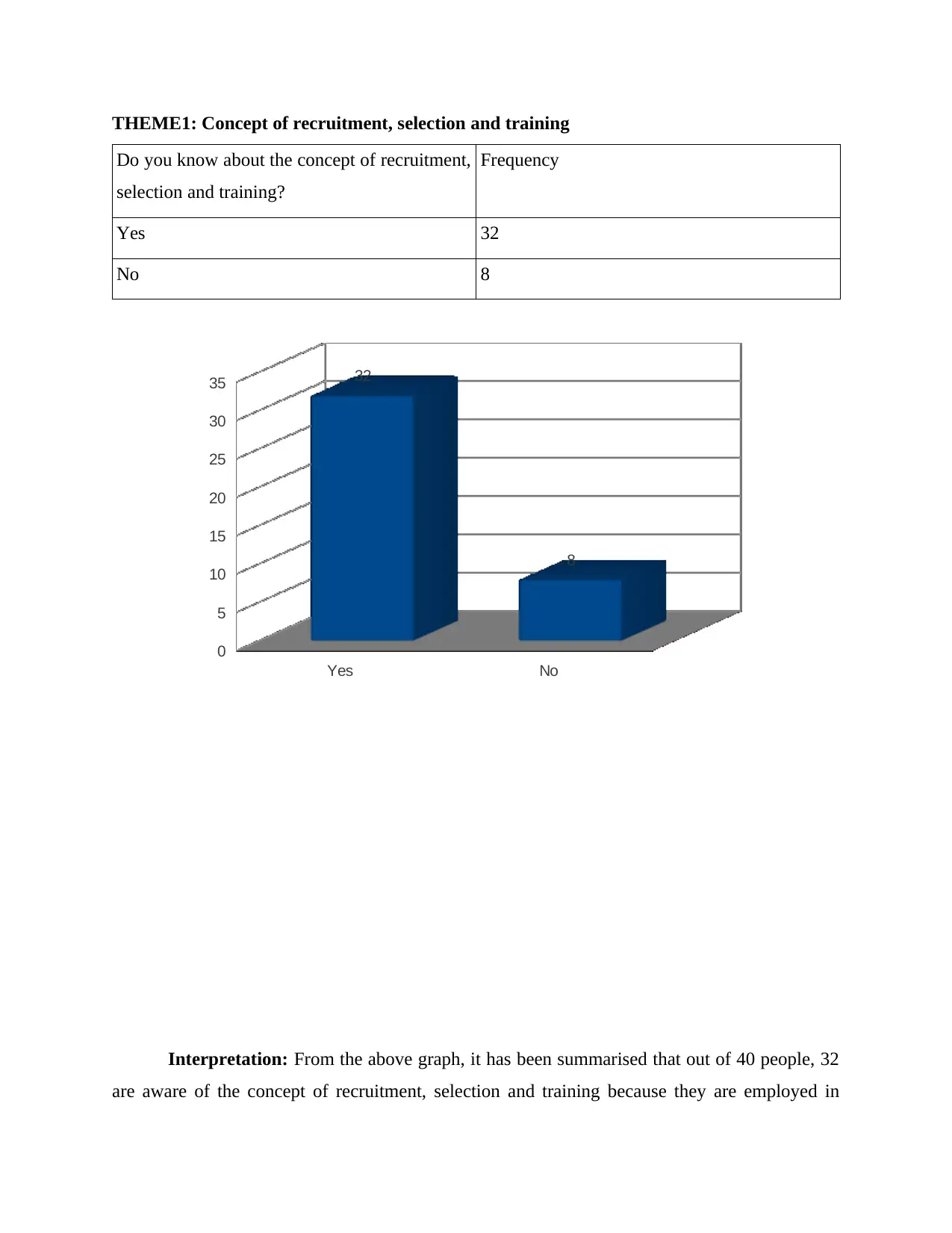
THEME1: Concept of recruitment, selection and training
Do you know about the concept of recruitment,
selection and training?
Frequency
Yes 32
No 8
Interpretation: From the above graph, it has been summarised that out of 40 people, 32
are aware of the concept of recruitment, selection and training because they are employed in
Yes No
0
5
10
15
20
25
30
35 32
8
Do you know about the concept of recruitment,
selection and training?
Frequency
Yes 32
No 8
Interpretation: From the above graph, it has been summarised that out of 40 people, 32
are aware of the concept of recruitment, selection and training because they are employed in
Yes No
0
5
10
15
20
25
30
35 32
8
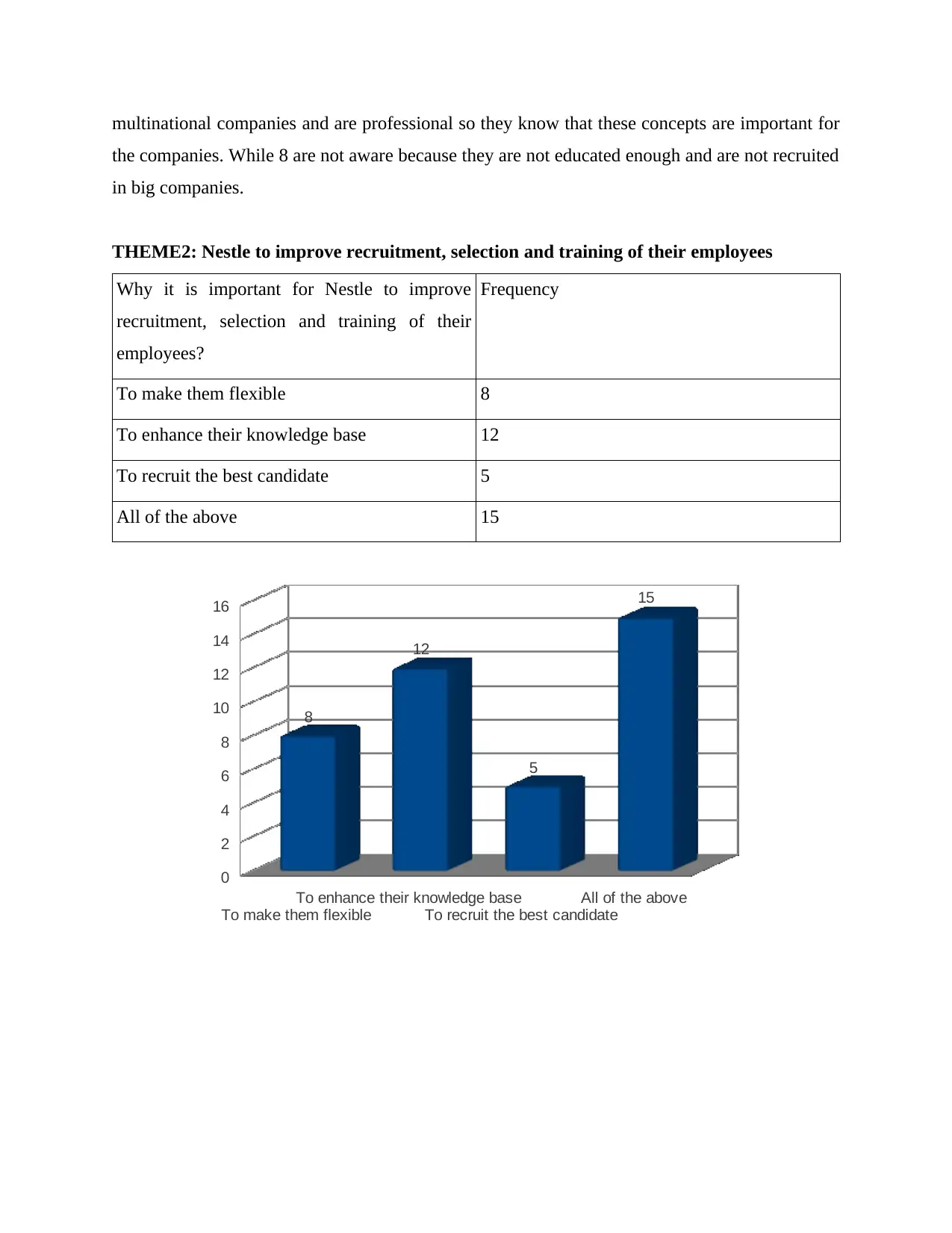
multinational companies and are professional so they know that these concepts are important for
the companies. While 8 are not aware because they are not educated enough and are not recruited
in big companies.
THEME2: Nestle to improve recruitment, selection and training of their employees
Why it is important for Nestle to improve
recruitment, selection and training of their
employees?
Frequency
To make them flexible 8
To enhance their knowledge base 12
To recruit the best candidate 5
All of the above 15
To make them flexible
To enhance their knowledge base
To recruit the best candidate
All of the above
0
2
4
6
8
10
12
14
16
8
12
5
15
the companies. While 8 are not aware because they are not educated enough and are not recruited
in big companies.
THEME2: Nestle to improve recruitment, selection and training of their employees
Why it is important for Nestle to improve
recruitment, selection and training of their
employees?
Frequency
To make them flexible 8
To enhance their knowledge base 12
To recruit the best candidate 5
All of the above 15
To make them flexible
To enhance their knowledge base
To recruit the best candidate
All of the above
0
2
4
6
8
10
12
14
16
8
12
5
15
⊘ This is a preview!⊘
Do you want full access?
Subscribe today to unlock all pages.

Trusted by 1+ million students worldwide
1 out of 26
Related Documents
Your All-in-One AI-Powered Toolkit for Academic Success.
+13062052269
info@desklib.com
Available 24*7 on WhatsApp / Email
![[object Object]](/_next/static/media/star-bottom.7253800d.svg)
Unlock your academic potential
Copyright © 2020–2025 A2Z Services. All Rights Reserved. Developed and managed by ZUCOL.





